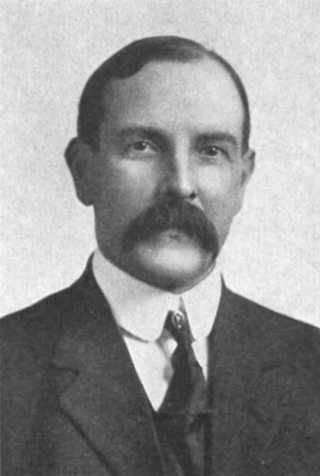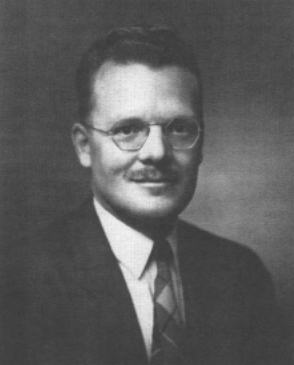
Jesse Merrick Smith (October 30, 1848 – April 1, 1927 [1] ) was a prominent American mechanical engineer, consulting engineer, patent expert, and president of the American Society of Mechanical Engineers in the year 1909-10.

Jesse Merrick Smith (October 30, 1848 – April 1, 1927 [1] ) was a prominent American mechanical engineer, consulting engineer, patent expert, and president of the American Society of Mechanical Engineers in the year 1909-10.
Smith was born Newark, Ohio, in 1848, the son of Henry and Lucinda Salisbury Smith. [2] In 1862 the family moved to Detroit, Michigan, where he attended Philo Patterson's School. After attended the Rensselaer Polytechnic Institute at Troy, New York from 1865 to 1868, he continued his studies in Europe. [3]
After a year of travel, Smith entered the Ecole Centrale des Arts et Manufactures in Paris in 1869, where he obtained the degree of Mechanical Engineer in 1872. After graduation he continued travelling through France, Belgium and Germany, visiting manufacturing plants along the way and attending lectures at the Technische Hochschule in Charlottenburg (now Technische Universität Berlin). From there he went to England spending another three months visiting iron and machine works. [3]
After returning to the States in 1973, he settled in Hocking County, Ohio and began the practice of engineering. He designed blast furnaces at the coal mines for smelting iron from native ores, and superintending the construction. In 1880 he moved to Detroit, Michigan where he started his own consulting engineering office. He designed both special machinery such as high-speed steam engine, as well as manufacturing and power plants, and overall design of manufacturing establishments. [3] [2]
Smith specifically developed the design of a "high-speed steam engine, with shaft governor, using the inertia principle... put into operation in connection with a Brush dynamo, operating 40 arc lights." [3] As representative of a Michigan electrical lighting company, he installed electrical installation. Among others he supplied the SM Stillman Hotel, Cleveland, Ohio with an electric light plant, and 1,000 lights, making that hotel first in the United States lighted exclusively and continuously by electricity. [3]
Since 1883 Smith had gotten engaged as expert witness in patent infringements cases at the United States courts, and over the years became an expert in a number of important suits. [2] In 1898 he moved to New York starting a consulting engineering office, exclusively devoted to patent expert work. [3]
The Cassier's Magazine (1909) recalled, that Smith acted on cases, such as "steam injectors, under the Hancock Inspirator patents; cylinder lubricators for locomotives; roller mills and middlings-purifiers for flour manufacture; cyclone dust collectors; quick-action air-brakes under the Westinghouse patents; pneumatic tires for automobiles; automobiles under the Selden patent; induction electric motors under the Tesla patents; pressure filters; incandescent electric lamps: steam-heating apparatus: typewriters; rein forced-concrete construction; the calculagraph, etc." [3]
Smith was member of the American Society of Mechanical Engineers since in 1883; the American Institute of Electrical Engineers; the American Institute of Mining and Metallurgical Engineers; the Société des ingénieurs civils de France; the Association amicale des anciens élèves de l'Ecole centrale des arts et manufactures; of the Engineering Society of Detroit; the American Association for the Advancement of Science; the American Geographical Society, the Engineers' Club of New York, and the Ohio Society of New York. [3] He was president of the American Society of Mechanical Engineers in the year 1909-10.
Jesse M. Smith. "The Profession of Engineering," in: Transactions of the American Society of Mechanical Engineers, New York City : The Society. Vol 31, 1909, p. 429-436

Charles Proteus Steinmetz was an American mathematician and electrical engineer and professor at Union College. He fostered the development of alternating current that made possible the expansion of the electric power industry in the United States, formulating mathematical theories for engineers. He made ground-breaking discoveries in the understanding of hysteresis that enabled engineers to design better electromagnetic apparatus equipment, especially electric motors for use in industry.

Arthur Edwin Kennelly was an American electrical engineer, physicist and mathematician.

Elmer Ambrose Sperry Sr. was an American inventor and entrepreneur, most famous for construction, two years after Hermann Anschütz-Kaempfe, of the gyrocompass and as founder of the Sperry Gyroscope Company. He was known as the "father of modern navigation technology".

John Edson Sweet was an American mechanical engineer, inventor, professor, businessman and president of the American Society of Mechanical Engineers from 1884–1885. He is known for building the first micrometer caliper in 1873, for making tools, and for inventing the "straight line" engine.
Charles Felton Scott was an electrical engineer, professor at Yale University and known for his invention of the Scott-T transformer in the 1890s.

Edwin Wilbur Rice Jr. was a president and considered one of the three fathers of General Electric.

Benjamin Garver Lamme was an American electrical engineer and chief engineer at Westinghouse, where he was responsible for the design of electrical power machines. Lamme created an efficient induction motor from Nikola Tesla's patents and went on to design the giant Niagara Falls generators and motors and the power plant of the Manhattan Elevated Railway in New York City.
Ernst Weber, Austria-born American electrical engineer, was a pioneer in microwave technologies and played an important role in the history of the New York University Tandon School of Engineering, where in 1945 he founded the Microwave Research Institute. Weber was also the first president of the Institute of Electrical and Electronics Engineers (IEEE) and one of the founders of the U.S. National Academy of Engineering (NAE).
Charles Brinckerhoff Richards was an engineer who worked for Colt's Patent Fire Arms Co., where he was responsible for the development of the Colt Single Action Army revolver. Richards was a founder of the American Society of Mechanical Engineers and a professor at Yale University where he taught for 25 years.

Engineering Magazine was an American illustrated monthly magazine devoted to industrial progress, first published in 1891. The periodical was published under this title until October 1916. Sequentially from Nov. 1916 to 1927 it was published as Industrial Management.

Horace See was an American mechanical engineer, marine engineer, naval architect, inventor, and superintendent. He is known as principal naval architect at the William Cramp & Sons shipyard in Philadelphia, and as president of the American Society of Mechanical Engineers in the year 1888–89.

Edwin Reynolds was an American mechanical engineer, consulting engineer and inventor, and president of the American Society of Mechanical Engineers in the year 1902-03. He is known for the development of the Corliss-Reynolds triple expansion pumping engine for water works.
Clarence Floyd Hirshfeld was an American electrical, mechanical and consulting engineer, educator, chief of research for the Detroit Edison Co., now DTE Electric Company, author, and inventor, who was awarded the John Fritz Medal posthumously in 1940.
James Hervey Herron Jr. was an American mechanical and consulting engineer, metallurgist, and founding president of the James H. Herron Company of Cleveland. He served as president of the American Society of Mechanical Engineers in 1937-38.
Crosby Field was an American mechanical and electrical engineer, manufacturer, vice president of the Brillo Manufacturing Company, and inventor. He is particularly known as inventor of the process to manufacture steel wool continuously, and as recipient of the 1953 ASME Medal.

Alan Howard was an American engineer, general manager of the Gas Turbine Department at General Electric Co., and inventor. He was known as "one of the world's leading authorities on the development and application of gas turbines," and recipient of the 1964 ASME Medal.
Ronald Bromley Smith was an American mechanical and consulting engineer, business executive with the Elliott Company and later with M. W. Kellogg Co., now KBR, Inc., and inventor. He is known as 82nd president of the American Society of Mechanical Engineers in 1963–1964.
Thomas Reeve Rosebrugh MA FRSC (1866–1943) was a Canadian electrical engineer, inventor, and professor of electrical engineering.
Carl Hering was an American engineer involved in studies on electric batteries and electric furnaces. He also made discoveries on electromagnetic force.
Frank William Peek Jr. was an American electrical engineer and inventor, known as a pioneer in engineering research on the creation of extremely high voltage electricity. He is often given the sobriquet "inventor of man-made lightning". He is known for Peek's law.